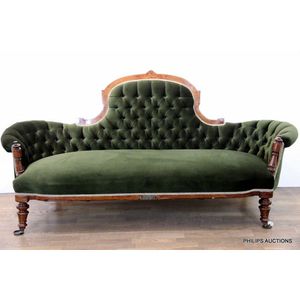Victorian Walnut Chaise Longue with Presentation Plaque
You must be a subscriber, and be logged in to view price and dealer details.
Subscribe Now to view actual auction price for this item
When you subscribe, you have the option of setting the currency in which to display prices to $Au, $US, $NZ or Stg.
- Stringing - Fine inlaid lines, in contrasting colour to the carcase timber, found mainly on furniture made in the styles of the later 18th and early 19th centuries. Stringing, which may be of satinwood, pine, ebony, horn, brass or occasionally ivory, is found principally on drawer fronts, around the outer edges of usually tapered legs and French bracket feet, around the edges of inlaid panels and between the joint of the cross banding and carcase timber on table tops, chests of drawers, cabinets etc. The effect is to emphasize the line of the piece and add to the impression of lightness and elegance. Stringing also occurs in Sheraton-revival-style furniture of the later 19th and early 20th centuries.
- Victorian Period - The Victorian period of furniture and decorative arts design covers the reign of Queen Victoria from 1837 to 1901. There was not one dominant style of furniture in the Victorian period. Designers used and modified many historical styles such as Gothic, Tudor, Elizabethan, English Rococo, Neoclassical and others, although use of some styles, such as English Rococo and Gothic tended to dominate the furniture manufacture of the period.
The Victorian period was preceded by the Regency and William IV periods, and followed by the Edwardian period, named for Edward VII (1841 ? 1910) who was King of the United Kingdom and the British Dominions and Emperor of India for the brief period from 1901 until his death in 1910. - Turning - Any part of a piece of furniture that has been turned and shaped with chisels on a lathe. Turned sections include legs, columns, feet, finials, pedestals, stretchers, spindles etc. There have been many varieties and fashions over the centuries: baluster, melon, barley-sugar, bobbin, cotton-reel, rope-twist, and so on. Split turning implies a turned section that has been cut in half lengthwise and applied to a cabinet front as a false decorative support.
This item has been included into following indexes:
Visually similar items

An early Australian cedar double ended settee upholstered in black cloth, circa 1830's. 95 cm high, 220 cm wide, 64 cm deep

A Pair of Anglo Indian Blackwood throne chairs, Bombay late 19th Century, (2) each shaped back profusely carved with foliate scrolls centred by a standing figure, with extensively carved arms fronted by rearing dragons, with a drop in seat, shaped and carv

Regency mahogany armchair, with curved back and carved scroll detail to arms, simple turned legs with brass castors, detached cushion and panels to back and front upholstered in red and brown trailing leaf pattern velvet. Height 108 cm, width 50 cm, depth

A fine Colonial cedar double ended settee c1840s. Elaborately carved Thomas Hope back, scrolling arms all resting turned & reeded legs. Upholstered in a tasteful green fabric with woven gold stars. Height 106 cm, width 225 cm, depth 65 cm. Provenance: The
